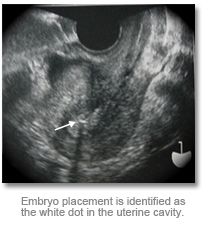What are the benefits of Embryo Transfer with Transvaginal Ultrasound?
By IVF Hawaii

If you are trying to get pregnant, you might wonder why you have not yet been successful. An infertility specialist can help you learn more about why you haven’t conceived and possible solutions. One of the tools that sets IVF Hawaii apart is their embryo transfer technique. There are three different ways for embryo transfer: (1) abdominal ultrasound, (2) blind technique with no ultrasound, and (3) vaginal ultrasound with embryo transfer. As one of the only doctors in Hawaii to offer this technique, Dr. Benton Chun specializes in embryo transfer with transvaginal ultrasound. He has found that this results in high pregnancy rates because of better visualization and higher picture quality. Here are reasons why you should request this procedure.
A Guide to Transvaginal Ultrasounds
What is a Transvaginal Ultrasound?
At IVF Hawaii, Dr. Chun strongly believes that transvaginal ultrasound guidance is the best technique for transferring the embryo back into the uterus. He finds this is the most successful method because certain areas of the uterine lining are more receptive for embryo growth. In addition, the clearer visualization and accurate placement of the embryo is a predetermined location of the uterine lining that optimizes successful implantation and growth.The embryo is placed in the thickest part of the endometrium because that area will have the most nutrients and blood supply. Lastly, this is a more comfortable option where the patient does not need to have a full bladder.
What Scans Reveal
 Transvaginal ultrasound scans provide a wealth of information about a woman’s reproductive health. These scans reveal fibroids, which are common benign growths in the uterus. Many go undetected, but they can affect the ability to get pregnant and increase the possibility of miscarriage. IVF treatment specialists can also see conditions like ovarian cysts resulting from endometriosis and thin uterine linings, both of which can reduce the potential for conceiving a child. Other medical conditions are uncovered as well, such as ovarian, vaginal, uterine, and kidney cancers, and pelvic inflammatory disease.
Transvaginal ultrasound scans provide a wealth of information about a woman’s reproductive health. These scans reveal fibroids, which are common benign growths in the uterus. Many go undetected, but they can affect the ability to get pregnant and increase the possibility of miscarriage. IVF treatment specialists can also see conditions like ovarian cysts resulting from endometriosis and thin uterine linings, both of which can reduce the potential for conceiving a child. Other medical conditions are uncovered as well, such as ovarian, vaginal, uterine, and kidney cancers, and pelvic inflammatory disease.
Follow Up after the Embryo Transfer
When a women gets pregnant, it means that the fertilized egg has implanted perfectly in the uterine lining where nutrients support the survival and growth of the embryo. At your follow up appointments after the embryo transfer has been completed, the doctor will be able to determine the success of the transfer and provide further guidance.
If you have been unsuccessful in getting pregnant, the infertility specialists at IVF Hawaii in Honolulu want to help you find out why. This compassionate fertility clinic team offers state-of-the-art treatments to families on Oahu, including the vaginal ultrasound transfer procedure that less than 10% of IVF doctors are able to perform. Learn more about this dedicated staff and their comprehensive services by visiting their website. To schedule a consultation appointment, call (808) 538-6655 today.
About the Business
Have a question? Ask the experts!
Send your question

